
Guava is a common tropical fruit cultivated in many tropical and subtropical regions. The common guava Psidium guajava is a small tree in the myrtle family (Myrtaceae), native to Mexico, Central America, the Caribbean and northern South America. The name guava is also given to some other species in the genus Psidium such as strawberry guava and to the pineapple guava, Feijoa sellowiana. In 2019, 55 million tonnes of guavas were produced worldwide, led by India with 45% of the total. Botanically, guavas are berries.
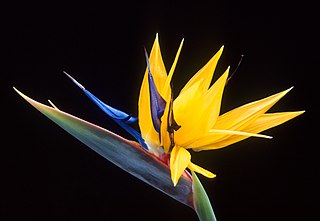
Strelitzia is a genus of five species of perennial plants, native to South Africa. It belongs to the plant family Strelitziaceae. A common name of the genus is bird of paradise flower/plant, because of a resemblance of its flowers to birds-of-paradise. In South Africa, it is commonly known as a crane flower.
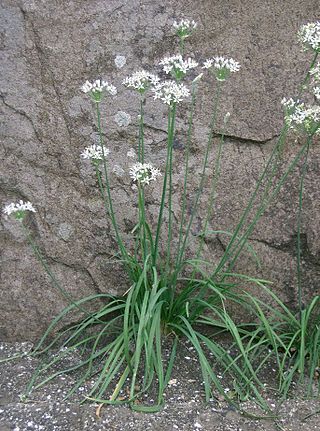
Allium tuberosum is a species of plant native to the Chinese province of Shanxi, and cultivated and naturalized elsewhere in Asia and around the world.
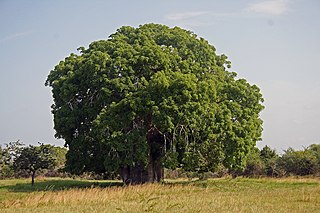
Adansonia is a genus made up of eight species of medium-to-large deciduous trees known as baobabs. They are placed in the Malvaceae family, subfamily Bombacoideae. They are native to Madagascar, mainland Africa, and Australia. The trees have also been introduced to other regions such as Asia. The generic name honours Michel Adanson, the French naturalist and explorer who described Adansonia digitata. The baobab is also known as the "upside down tree", a name that originates from several myths. They are among the most long-lived of vascular plants and have large flowers that are reproductive for a maximum of 15 hours. The flowers open around dusk, opening so quickly that movement can be detected by the naked eye, and are faded by the next morning. The fruits are large, oval to round and berry-like and hold kidney-shaped seeds in a dry, pulpy matrix.

Wheatgrass is the freshly sprouted first leaves of the common wheat plant, used as a food, drink, or dietary supplement. Wheatgrass is served freeze dried or fresh, and so it differs from wheat malt, which is convectively dried. Wheatgrass is allowed to grow longer and taller than wheat malt.

Agathosma is a genus of about 140 species of flowering plants in the family Rutaceae, native to the southern part of Africa. Common names include buchu, boegoe, bucco, bookoo and diosma. Buchu formally denotes two herbal species, prized for their fragrance and medicinal use despite their toxicity. In colloquial use however, the term is applied to a wider set of fragrant shrubs or substitutes.

Moringa oleifera is a fast-growing, drought-resistant tree of the family Moringaceae, native to the Indian subcontinent and used extensively in South and Southeast Asia. Common names include moringa, drumstick tree, horseradish tree, or malunggay.

Agathosma betulina is a flowering plant in the family Rutaceae, native to the lower elevation mountains of western South Africa, where it occurs near streams in fynbos habitats.
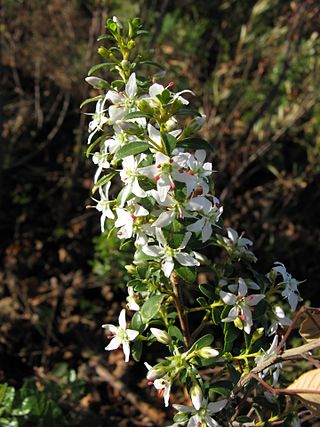
Agathosma crenulata is a flowering plant in the family Rutaceae, native to the lower elevation mountains of southwestern South Africa, where it occurs near streams in fynbos habitats. It is an evergreen shrub growing to 1.5-2.5 m tall. The leaves are opposite, oval, 15–35 mm long and 7–18 mm broad. The flowers are white or pale pink, with five petals; the fruit is a five-parted capsule which splits open to release the seeds.

Anemone hepatica, the common hepatica, liverwort, liverleaf, kidneywort, or pennywort, is a species of flowering plant in the buttercup family Ranunculaceae, native to woodland in temperate regions of the Northern Hemisphere. This herbaceous perennial grows from a rhizome.

Callicoma is a plant genus that contains just one species, Callicoma serratifolia, a tall shrub or small tree which is native to Australia. Callicoma serratifolia is commonly known as black wattle. One explanation for the name is the similarity of the flowers to those of Australian Acacia, which are commonly known as wattles. Another is its use in wattle and daub huts of the early settlers. The species has a number of other common names include callicoma, butterwood, silver leaf, silver-leaf butterwood and wild quince.

Coleonema is a genus of flowering plants in the family Rutaceae. The eight known species are all from the western Cape Province of South Africa. In Australia, where they are cultivated as garden ornamentals, they are often referred to as Diosma, a different genus in the same family.
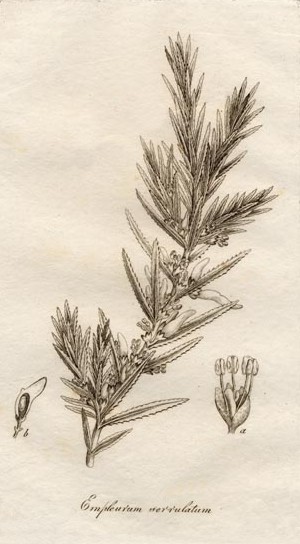
Empleurum unicapsulare or false buchu is a South African shrub of the family Rutaceae and occurs from the southwestern districts of the Cape Province to the Uitenhage area.

Actinidia polygama is a species of kiwifruit in the Actinidiaceae family. It grows in the mountainous areas of Korea, Japan and China at elevations between 500 and 1,900 metres.
Boegoe is a word of Khoikhoi origin, which may refer to a number of South African plants, fungi or a mineral, that were used in traditional preparations. Most Boegoe plants are typified by a strong aromatic odour due to volatile oils released by glands in the leaves. The name primarily denotes those plant species of which the stems, powdered leaves or volatile oils are employed in herbalism.
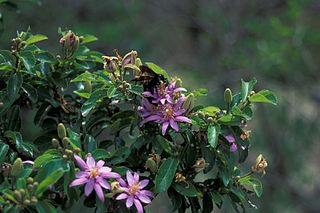
Grewia occidentalis, the crossberry, is a species of deciduous tree indigenous to Southern Africa.
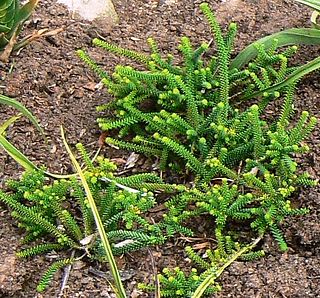
Agathosma gonaquensis, commonly known as Gonaqua buchu, is a species of plant in the family Rutaceae. Its habitat is restricted to a tiny area of the Eastern Cape, South Africa. According to the South African National Biodiversity Institute, it is critically endangered.

Stipagrostis namaquensis is a species of grass native to Botswana, Namibia, Lesotho, and the Cape Provinces and Free State of South Africa, especially in the Nama Karoo. It is listed as "safe" (LC) on the SANBI Red List.

Delosperma lehmannii is a succulent plant native to parts of the Eastern Cape Province of South Africa. Sometimes called ice plant, it is grown as a decorative houseplant for its distinctive smooth, angular leaves. The specific epithet lehmannii honors the German professor of botany in Hamburg Johann Georg Christian Lehmann.
Diosma haelkraalensis, or Hagelkraal's diosma, is a rare species of plant endemic to the southwestern Cape Provinces of South Africa.

















